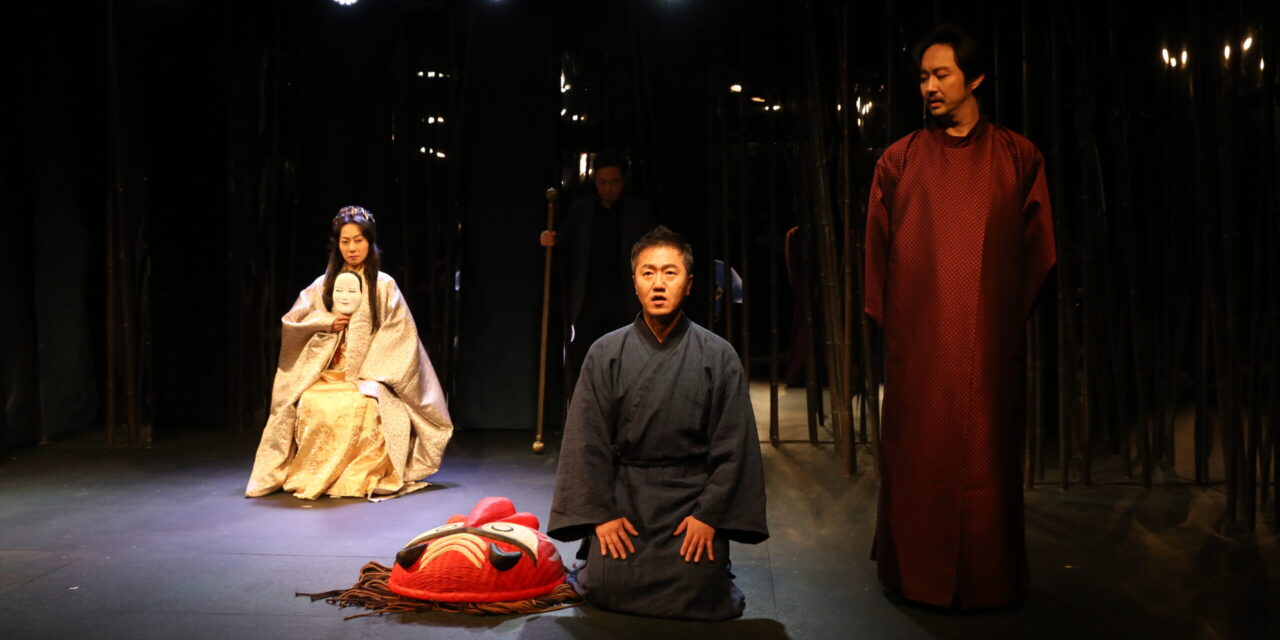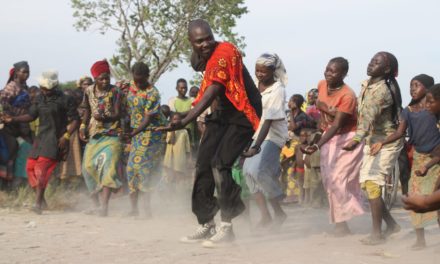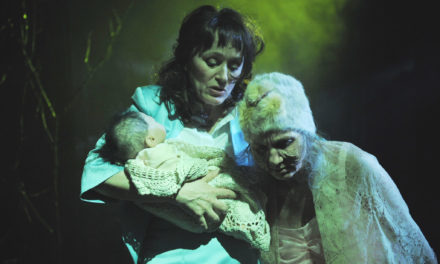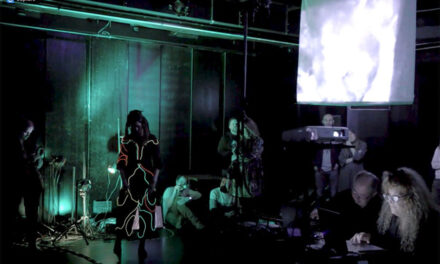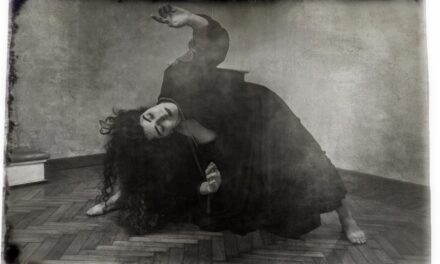The Korean theatre company The Nanhee premiered its new production Mimaji!, written and directed by Myung-Wha Kim, at Bom Studio Theatre in Seoul, Korea, on November 26, 2020.
Mimaji is the name of the Korean artist from Baekje, one kingdom of the Three Kingdoms of Korea period (57 BC to 668 AD), alongside Goguryeo and Silla. He is credited with introducing kiak, a Buddhist masked dance processional, to the Japanese Court in 612, and thus initiating the “Korean wave (hallyu)” about 1,400 years before the term was coined. Kiak was presumably popular among the common people in Baekje around the sixth century. But the lack of substantial early records left different interpretations about how it originated. In addition to bringing kiak to Japan, Mimaji also established an official school in Japan to train Japanese dancers and musicians in that form, which in Japan came to be called gigaku. The performance was in silent mime to the accompaniment of music, featured masked performers depicting exaggerated archetypes, and told stories with farcical and lascivious plots. The regent Shotoku’s appreciation of Buddhism helped kiak to be performed as court entertainment and as a Buddhist ceremonial promoting the religion. Kiak peaked in the first half of the eighth century but gradually declined after the imperial palace designated bugaku as its official entertainment. In contrast with kiak, bugaku depicted legends or mythical stories with slow and regal movements and has remained the imperial court’s primary entertainment to the present day. Even after its decline in the imperial court, kiak was still performed and taught in regions far away from the capital. While kiak did not leave much-documented history or description of its performance, it is recognized for its significant influence on Noh theatre, especially the use of masks, and other Japanese theatre forms. In Korea, kiak resurfaced in the mid-twentieth century when Doctor Hae-Goo Lee accidentally found a record of it, despite it being only a few sentences, in ancient Japanese documents. In 2003, the Kiak Preservation Society was founded with the mission of restoring the legacy of kiak.
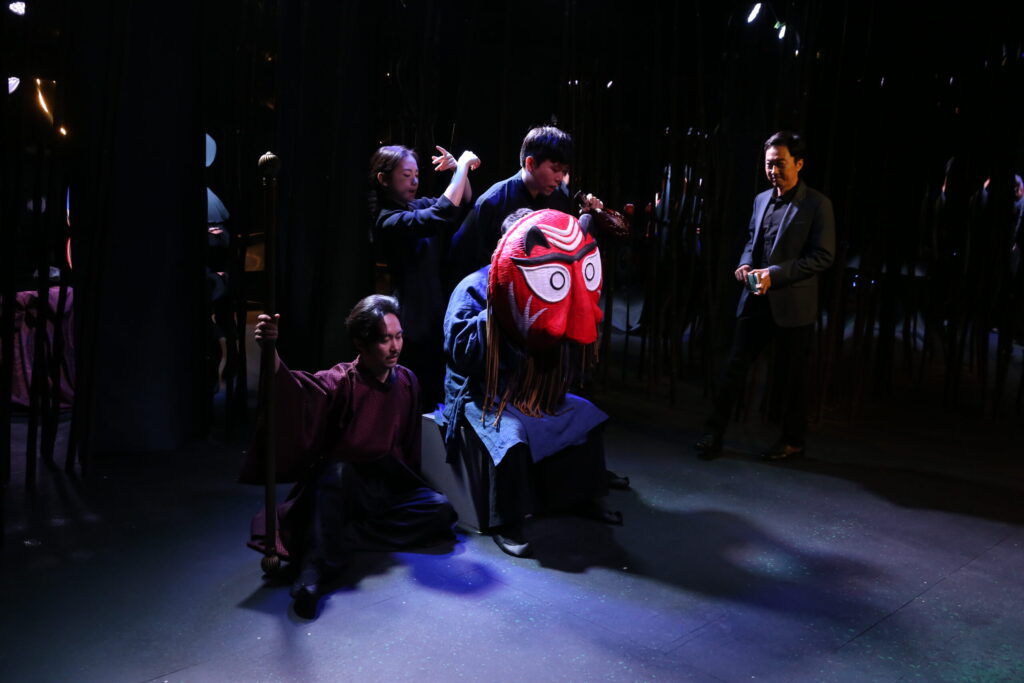
Il Kwon, An-Jin Shin, Da-Hye Lee, Kang-Hyeon Choi, and Ik-Nam Baek in Mimaji! Photo Credit: So_l Kim
Mimaji is indeed a very unfamiliar name to the Korean audience and minimally referenced even in scholarship. Given the scarce status of Mimaji in Korean culture, The Nanhee’s Mimaji! is an ambitious and pertinent project for its effort to illuminate Mimaji’s accomplishment as the first Korean artist to introduce and spread Korean art abroad. With the recent international success of Korean culture – the film Parasite (2019) becoming the first foreign film to win the Best Picture Award at the 92nd Academy Awards, the K-pop band BTS becoming an international phenomenon, K-food, and K-drama, to name a few – the exploration of the origin of the Korean wave is timely and can place the recent Korean wave in a historical context. The trajectory from Mimaji to Parasite and BTS, and the numerous Korean cultural and artistic exports in between and still upcoming, not only marks the remarkable artistic and cultural accomplishments throughout Korean history but also affirms the Korean maxim, “What is most Korean is what is most global.”
For The Nanhee, founded by playwright Myung-Wha Kim in 2018, Mimaji! marks the company’s continued effort to explore the origin of theatre, following Hamlet, the Dead Man Tells No Tales, a modern adaptation of Hamlet, and Dionysus Under the Magnolia, a reinterpretation of the origin of Western theatre, both written by Myung-Wha Kim. In her search for the origin of Asian theatre, Kim was inspired to research Mimaji, follow his footsteps in the region that used to be Baekje, and imagine his creation of kiak and his journey from Korea to Japan. She completed the script for Mimaji! in November 2019, kept developing it through staged readings and audience feedback, and had a tryout performance at Daehakro’s Yohangza theatre in Seoul on June 19 and 20, 2020.
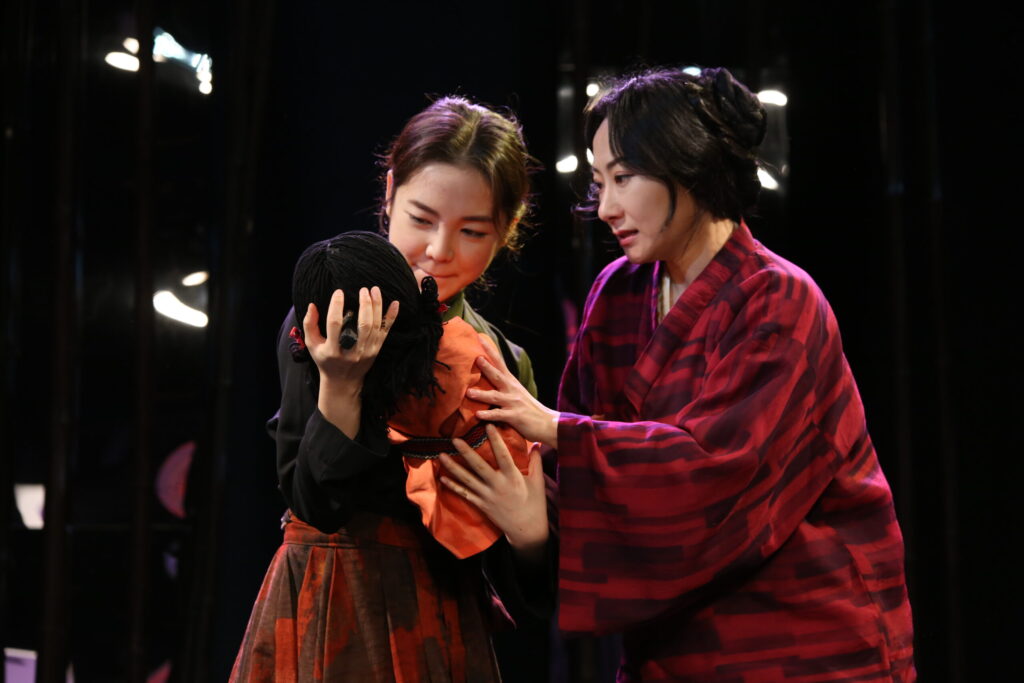
Da-Hye Lee and Zia Zhang in Mimaji! Photo Credit: So_l Kim
The play draws a narrative with a focus on Mimaji as a person, his introduction of kiak to Japan, and his agony as an artist navigating the religious and the worldly realms in the context of the cultural exchange between Baekje and Japan. Featuring traditional Korean dance and live musical performance with traditional Korean musical instruments, the play poses the questions: What made Mimaji leave his motherland Baekje? How have the relationships he formed through his travels influenced and inspired his development of kiak? And what was his ultimate artistic ideal? The company invites the audience on a journey in search of kiak, the original Korean wave, and to explore how the inherently Korean sentiment, form, and characteristic appeal across and beyond the national and cultural borders.
The production ran from November 26 to December 6, 2020. To prevent the spread of Covid and ensure a safe viewing experience, the company followed the government regulation for safety, including socially distanced seating, thorough disinfection of the theatre, and mandatory use of face masks for all personnel.
Performers: Ik-Nam Baek, An-Jin Shin, Zia Zhang, Il Kwon, Kang-Hyeon Choi, Da-Hye Lee
Live Musicians: Min-Cheol Seon (Piri/Tapyongso), Juri Jeong (Percussion), Hye-Young Hwang (Geomungo/Yangguem)
Set Design: Ho-Sung Shon
Lighting Design: Chang-Gi Kim
Costume Design: Jin-Young Ryu
Makeup: Dong-Min Lee
Sound Design and Original Music: Eun-Young Kang
Movement: Bae-Sub Keum
Stage Management: Dong-Han Sung
Assistant Director: Hyeong-Sik Kim
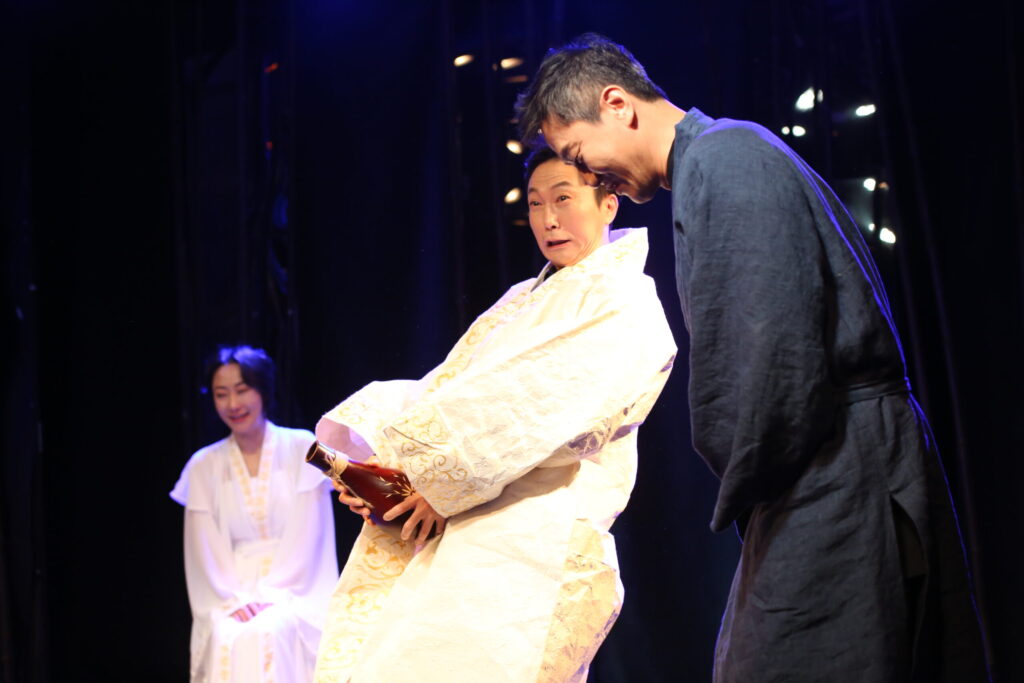
Baek, and An-Jin Shin in Mimaji! Photo Credit: So_l Kim
Zia Zhang, Ik-Nam Baek, and An-Jin Shin in Mimaji! Photo Credit: So_l Kim
The following interview with Myung-Wha Kim was conducted via email on December 17, 2020, and was translated from Korean by Walter Byongsok Chon.
Walter Byongsok Chon: Congratulations on the premiere and a successful run of Mimaji! How are you feeling at the moment?
Myung-Wha Kim: It feels like I finally completed an assignment that I worked on for a while. I feel both exhausted and relieved. Since it is time to wrap up the year anyhow, this is not a bad feeling.
Chon: How did you first learn about Mimaji? And what inspired you to write about a play about him?
Kim: I remember reading a few sentences about him in a Korean theatre history book when I was young. I founded my theatre company The Nanhee in 2018 and created a few pieces exploring origins. My search for the origin of Asian theatre inspired me to write Mimaji!.
Chon: Could you share the process of writing and completing the play? How did your research, the site visits, the staged reading, the tryout performance, the feedback from the audience, and the rehearsals help the play come into shape?
Kim: The play indeed developed over several stages through a long developmental process. It was the Kiak Preservation Society in Gongju (in South Chungcheong province in South Korea, the capital of Baekje from AD 475 to 538) that first suggested a dramatization of Mimaji’s life. I received some funding to develop a forty to fifty-minute play for a showcase staged reading. I looked up lots of articles and documents for research. However, the Kiak Preservation Society, being mainly interested in presenting the piece for the festival, did not continue supporting the development of the play after the staged reading.
So I took it upon myself to continue writing the play. It felt like what I read about kiak and Mimaji in Korean theatre history became an essential part of me, like destiny. To learn more thoroughly about the details of the history, I consulted scholars of Japanese literature and theatre history and integrated my research into my writing. I shared the research with my cast and artistic team, and we even improvised a few scenes together in rehearsal. These steps helped me complete the play.
For the staged reading, we received support from the Seoul Foundation for Arts and Culture. With the funding, we could invite Korean traditional music composers and musicians and create music that would approximate the attributes of kiak. Even though no original music from Baekje survives, the traditional Korean music helped the audience feel as if they were transported to that period. With live musical performance, our staged reading achieved a high level of artistry.
After the staged reading, the cast, artistic team, and I took a field trip to Gongju, Buyeo, and Iksan, which were all part of Baekje. In preparation for the next stage of our piece, we wanted to breathe the air of the historic sites and let them inspire our imagination. We would have visited Japan, too, had it not been for the Coronavirus and the lack of funding.
After our trip, we staged a tryout performance. This time we received support from the Arts Council of Korea. To make the performance as complete as possible, we had a full set, costumes, projection, and live musical performance, and invited choreographer Cha Hee, an expert in traditional Korean dance. (This choreography was taken out of the main production for artistic differences.)
At the tryout performance, I realized that the stage was too packed and left no room for the audience’s imagination.
Therefore, the next step involved lots of cutting, revision, and addition. For the main production, we took out the projection. For the movement and choreography, we invited my longtime colleague Bae-Sub Keum who added a stylized theatrical touch to the movement. While the previous draft of the play focused mainly on kiak and Mimaji, the new draft reflected the form of kiak as a silent masked Buddhist performance. By this point, the performers completely embodied the characters and developed great chemistry with one another.

Myung-Wha Kim
Chon: How do you reflect on your journey writing this play?
Kim: During the long process of writing this play, visiting the old Baekje area, the tryout performance, and leading up to the main production, several people that I loved passed away. As I experienced these losses, the play as well as the original intention changed and evolved little by little. At the beginning of writing, what drove me was my curiosity about kiak and Mimaji, how they would resonate today, and my exploration of the essence of art in a time of war. Then all of a sudden, I reached a state of void. I wanted to fill that void with color and form. (This quote also appears in Korean in The Korean Theatre Review, where the play will be published.)
Chon: As a director, how did you integrate the live music and choreography into the narrative on stage?
Kim: The staged reading and the tryout performance during the two-year-long development process really helped us find a balance among the different elements on stage. We found that, with each iteration, the various elements on stage found ways to enhance one another to create a rich and harmonious world on stage.
Chon: The Coronavirus struck a huge blow to the theatre industry. What were your biggest challenges dealing with the pandemic?
Kim: Just before the opening of the tryout performance, we had to change the performance space. Also, just before opening the main production, there was a drastic increase in corona cases, so we were not sure whether we could open, whether it would be safe, or whether people would show up. The biggest challenge was the anxiety. Artistic creation itself is already a nerve-racking activity, and the anxiety of the pandemic made it all the more difficult.
Chon: Could you share a little bit about your next project, as a director or as a playwright?
Kim: My works for the past few years have focused on the search for origin. More specifically, I delved into the origins of Western and Asian theatre and the connection between the origins and the present. My next project, the last piece of the origin series, is my play Yi Kwang-Su’s Dream, and Flower from my Collected Plays Vol. 2. (Yi Gwang-Su, 1892 – 1950, is a Korean author, literary critic, journalist, and activist. His novel The Heartless (Mujong) from 1917 is described as the first modern Korean novel. While he participated in Korea’s independence movement, he is also known for his pro-Japanese activities in the later years of the Japanese occupation of Korea, which lasted from 1910 to 1945.) I plan to examine Korea’s modernity through the Korean mythology in Samguk Yusa (The Romance of the Three Kingdoms. A collection of folktales and legends from and around the Three Kingdoms of Korea period, which also includes the record of the founding of Korea as Gojoseon by Dangun. Estimated date of compilation: 1280s. Earliest extant publication: 1512). I would like to examine Korea’s modernity, which initiated with a pro-Japanese sentiment, in relation to Korea’s mythological origin. When this play premiered as Dream at the National Theater Company of Korea ten years ago, it was criticized for having Yi Gwang-Su as its protagonist. (Because of the history of the Japanese occupation) Japan has always been a sensitive subject in Korea. The trauma caused by the criticism kept me from writing for a few years. Now I am ready to face that hot potato again. This time I am also directing it myself.
Chon: Thank you for sharing your thoughts! I wish you the best with Yi Gwang-Su’s Dream, and Flower.
Myung-Wha Kim is a playwright and director. She made her debut as a playwright with Birds Do Not Cross the Crosswalk, which won the Samsung Literary Award for Best Play in 1997. Her plays include First Birthday, The Wind’s Desire, Redolence, and The End of the Royal Palace Dining Hall, among others. She won numerous awards including the Cha Beom-Seok Theater Award, Daesan Literary Award, Dong-A Theater Award, the Grand Prize in the Asahi Shimbun Theatrical Arts Award, and Yeo Seok-Gi Theater Critic Award. She founded Nanhee Theatre Company in 2018, which became The Nanhee in 2020, and took up directing. The Nanhee’s productions include Mimaji!, Dionysus Under the Magnolia, and Cold Noodles.
Video Link for the Trailer of Mimaji!
Video Link for the Interview with the Actors and the Director for the Tryout Performance (in Korean)
This post was written by the author in their personal capacity.The opinions expressed in this article are the author’s own and do not reflect the view of The Theatre Times, their staff or collaborators.
This post was written by Walter Byongsok Chon.
The views expressed here belong to the author and do not necessarily reflect our views and opinions.

